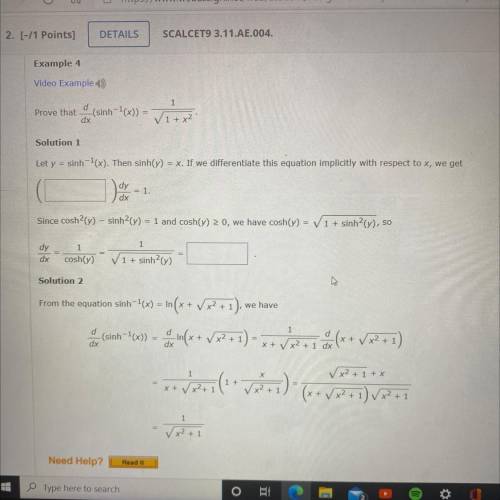Example 4
Video Example
Prove that -(sinh-l(x)) =
dx
√1+x²
Solution 1
...

Mathematics, 18.05.2021 06:40, zmerriweather167
Example 4
Video Example
Prove that -(sinh-l(x)) =
dx
√1+x²
Solution 1
Let y
sinh (x). Then sinh(y) = x. If we differentiate this equation implicitly with respect to x, we get
1.
dx
Since cosh?() - sinh?(y) = 1 and cosh(y) 2 0, we have cosh(y) - 1 + sinh?(y), so
1
dy
dx
1
cosh(y)
V1 + sinh?v)
Solution 2
we have
From the equation sinh-+(x) = \n(x + V x2 + 1).
-(sinh 'x) - 4 n(x + 2 + 1)-- --4(x + x + 1)
dx
- ** V*2+1 ( + vota)-
√²+1+x
1+1
+ 1
1


Answers: 2
Other questions on the subject: Mathematics

Mathematics, 21.06.2019 17:00, themajesty9898
Twice the sum of a number and 4 is equal to three times the difference of the number and 7. find the number.
Answers: 1

Mathematics, 21.06.2019 20:00, brevenb375
What effect would doubling all the dimensions of a triangular pyramid have on the volume of the pyramid? explain your reasoning.
Answers: 1

Mathematics, 21.06.2019 23:10, ineedhelp2285
The input to the function is x and the output is y. write the function such that x can be a vector (use element-by-element operations). a) use the function to calculate y(-1.5) and y(5). b) use the function to make a plot of the function y(x) for -2 ≤ x ≤ 6.
Answers: 1

Mathematics, 22.06.2019 02:50, salazarx062
There are 85 apples on the big tree, john picked out 15%. how many did john pick out?
Answers: 2
Do you know the correct answer?
Questions in other subjects:




Business, 12.12.2019 04:31











